Top 10 most incredible airports in the world
Exploring the world and connecting cultures has never been as exciting and accessible as it is today, and behind this fascinating possibility are the incredible airports that greet us with their bold, modern designs. These architectural monuments are much more than just infrastructure, they are gateways to new adventures and testaments to human ingenuity.
Constantly evolving with modern technology, today’s airports have not only revolutionized the way we travel, but have also become true works of art in terms of design and spatial integration. With an eye to the future, these impressive transportation hubs have become the epicenter of innovation, where functionality and traveler movement capacity merge with exquisite planning.
The growing demand for international travel has led to the construction of new airports that challenge the limits of what is possible. Conceived as true cities in themselves, these airport projects not only seek to facilitate air mobility, but also to integrate with their surroundings, in harmony with sustainability and respect for the environment.
From majestic terminals that seem to defy gravity to runways strategically designed to face the most imposing geographical challenges, each of these ten selected airports stands out for its uniqueness and beauty. To enter these amazing structures is to immerse oneself in a world of architectural wonders that transcend the merely functional, awakening emotions and leaving an indelible mark on those who have the privilege of visiting them.
We will travel to the four corners of the globe, discovering from urban oases to imposing palaces of the air, all with a common denominator: the ability to surprise and amaze us with their splendor. Join us on this exciting journey through the “10 Most Incredible Airports”, where human creativity and vision merge to give life to these jewels of modern architecture.
Beijing Daxing International Airport in China

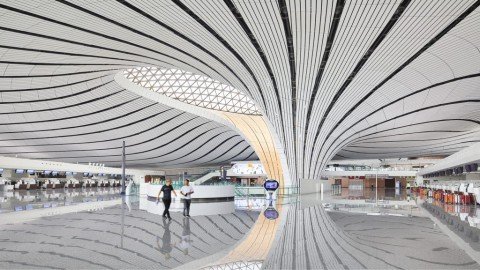
Plunging into the heart of China’s stunning capital, we come across Beijing Daxing International Airport, an architectural marvel that defies the limits of creativity and modern engineering. Conceived by renowned Zaha Hadid Architects, this colossal transportation hub is located in the Daxing district and has been meticulously designed to accommodate the unstoppable growth of air traffic in the region.
Upon entering this architectural prodigy, a majestic structure capable of accommodating approximately 45 million passengers per year is revealed. But that’s not all! This impressive airport has been designed to adapt to the growing demand, and it is estimated that by 2025 it will have the capacity to receive an impressive 72 million passengers annually. A true aviation colossus that never ceases to amaze us with its ambition and vision for the future.
Aware of the importance of connectivity, the designers of Beijing Daxing Airport have integrated various transport options to facilitate access from the city and its surroundings. Modern intercity rail and subway systems are strategically intertwined with ground transportation, allowing for a continuous flow of travelers to and from this monumental architectural masterpiece.

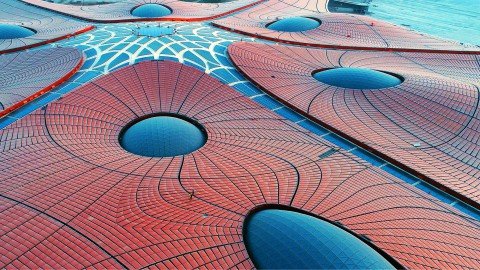
But it is its design that truly mesmerizes those who have the privilege of contemplating it. Inspired by traditional Chinese architecture, the airport adopts an organic form composed of six fluid structures that seem to dance in perfect harmony. These forms intertwine and connect around a central courtyard, creating interconnected spaces that invite travelers to immerse themselves in an atmosphere of serenity and avant-garde.
The experience of traversing this exceptional airport is a true architectural odyssey. Its curved lines and innovative design offer a sense of fluidity and modernity, while nods to Chinese tradition enhance its cultural identity.
Beijing Daxing International Airport, a prodigy conceived by Zaha Hadid Architects and materialized in 2019, is not only a transit hub for millions of people, but also a statement of excellence in modern design and engineering. It is an icon that symbolizes the human capacity to dream big and transform those dreams into magnificent realities, a gateway to the wondrous and ancient land of China, and a travel experience that captivates from the moment you step onto its unparalleled ground.
Location: Beijing, China
Design: Zaha Hadid Architects
Madrid-Barajas Airport


Welcome to an iconic destination in the enchanting city of Madrid, Spain, where majesty and efficiency merge to bring Madrid-Barajas International Airport to life. With four impressive terminals, this colossal transportation hub stands proudly as the second largest airport in all of Europe, attracting millions of travelers each year.
The jewel in the crown is undoubtedly the airport’s fourth terminal, a masterpiece of sustainable design conceived by the talented team of Estudio y Rogers Stirk Stirk Harbour + Partners. Strategically located in the northernmost area of the older terminals, this terminal is much more than just a departure or arrival point: it is an architectural experience that captivates the senses.
From its conception, it has sought to make a difference with a cutting-edge approach to sustainability. This terminal is the best example of environmentally conscious architecture, where every detail has been meticulously taken care of to minimize environmental impact and maximize energy efficiency.


Light is the undisputed protagonist in the design of this airport marvel. Structural systems with light-filled cannons have been ingeniously arranged to bathe the interior of the terminal in natural lighting, thus significantly reducing energy requirements and creating a warm and welcoming environment for travelers. Every step inside the terminal is a walk through luminosity, where open, well-lit spaces invite us to immerse ourselves in a unique travel experience.
Functional design also plays a crucial role in this terminal. It consists of a parking building divided into six modules and connected by intelligently laid out paths that guide us to the terminal building, characterized by three linear modules that extend elegantly. This strategic layout ensures efficiency in passenger flow and creates a sense of comfort and accessibility in every corner.
Madrid-Barajas International Airport stands as an example of the union between human ingenuity and respect for the environment. Every corner of this sustainable terminal is an example of how architecture can be integrated in harmony with nature, without compromising excellence in functionality.
Location: Madrid, Spain
Design: Estudio Lamela and Rogers Stirk Harbour + Partners
Jewel Changi Airport in Singapore
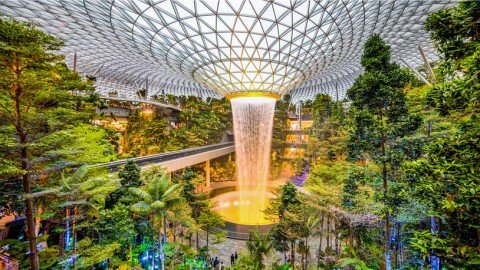

Welcome to a true aerial paradise, where the genius of architect Moshie Safdie merges with the lush beauty of Singapore. We find ourselves at Changi Airport, a masterpiece of design that redefines the travel experience. With a distinctive touch that enamors every visitor, this architectural marvel has earned its place as a true landmark in the “City in the Garden”.
A true jewel in the airport ensemble, Terminal 3 defies the limits of convention and invites us to immerse ourselves in a unique experience. Designed as a connector between the existing terminals, this architectural marvel is more than just a transit space: it is an exciting encounter between a bustling marketplace and a garden paradise.
The design of this terminal focuses on community, offering travelers and visitors a place where hustle and bustle and tranquility intertwine in perfect symbiosis. The architect has conceived this space as a gathering area, where people can interact, enjoy each other’s company and experience the essence of Singapore in all its splendor.
But it is at the heart of this jewel that its true magic lies. Inspired by a semi-inverted toroidal dome shape, the terminal’s design is an ode to nature and Singapore’s reputation as the “City in the Garden.” An impressive interior waterfall element, known as the “rain vortex,” occupies the center of the terminal, stunning everyone with its splendor.

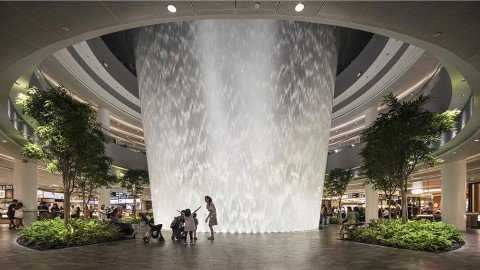
This majestic rain vortex is not only a dazzling visual spectacle, but also plays a vital role in the passenger experience. Descending gently from above, it cools the environment naturally, dissipating heat and creating a cool, welcoming environment similar to a nearby forest – a true symphony of architecture and nature!
Changi Airport is much more than just a transit terminal; it is a destination in itself. Exploring this oasis of design and sustainability is a real treat for the senses. Every corner reveals a new surprise, a new wonder, and the terminal becomes a canvas where travelers write unforgettable stories.
So get ready to be captivated by the magic of Changi, where the talent of Moshie Safdie meets the essence of Singapore to offer us an aerial experience like no other. Step into this garden paradise and feel how architecture and nature merge in a perfect embrace.
Location: Singapore
Design: Safdie Architects
Queen Alia Airport in Jordan


We are at Queen Alia International Airport in Jordan, an outstanding example of passive design that has masterfully embraced Bedouin tradition and modernity.
This airport is a living testament to how architecture can adapt to its environment and climate in a sustainable manner. Its structure has been conceived to be flexible, allowing for future expansion that, by 2030, could increase its capacity to accommodate travelers from 3.5 million to an impressive 12 million.
The terminal is a tribute to Bedouin tradition, drawing inspiration from the iconic Bedouin tents that have been a symbol of hospitality and resilience in the desert. The roof structure, which stretches like a majestic canopy, spans the entire terminal and is composed of 127 concrete domes. This choice is not only aesthetic, it is also functional and responds directly to Amman’s climate.
Concrete was the material of choice for the roofs because of its high thermal mass, which passively controls the terminal’s internal temperature. In an environment where temperatures can be extreme, this architectural decision ensures a comfortable experience for travelers and efficient energy management.


But Queen Alia International Airport’s adaptability doesn’t stop there. Its flexible design has been conceived to grow with demand, evolving as time and needs dictate. A visionary approach that allows us to look to the future with optimism and ensures that this airport continues to be an iconic gateway to fascinating Jordan.
Queen Alia International Airport is much more than an arrival or departure terminal, it is a symbol of the human capacity to honor the past while embracing the future. Every corner is a celebration of architectural ingenuity and a tribute to the culture and climate of this ancient land.
Prepare to immerse yourself in the beauty of an airport that has become an emblem of passive design and sustainability, welcoming travelers with open arms, just as Bedouin tents welcome visitors to Jordan’s vast desert.
Location: Amman, Jordan
Design: Foster + Partners
Denver Airport


Welcome to an airport that seems to have been sculpted by the whims of nature and honors the spirit of the surrounding environment. We are at the majestic Denver International Airport, a true architectural marvel and one of the most prominent transportation hubs in the United States of America.
With an imposing wingspan that places it as the second largest airport in the country and one of the five busiest, this destination is much more than a point of departure or arrival. Its design is a showcase of how architecture can embrace sustainability and reduce environmental impact without sacrificing splendor and functionality.
Fentress, a visionary in the world of architecture, has created an airport that integrates harmoniously with its surroundings. With a focus on sustainability, the use of natural light has been maximized, thereby reducing energy consumption and creating a welcoming environment for travelers.
The impressive peaked roof structure, which resembles a majestic snow-capped mountain, rises majestically to a height of 130-150 feet (39.6-45.7 meters). Supported by catenary steel cable systems, this architectural marvel becomes a symbol of grandeur and resilience.
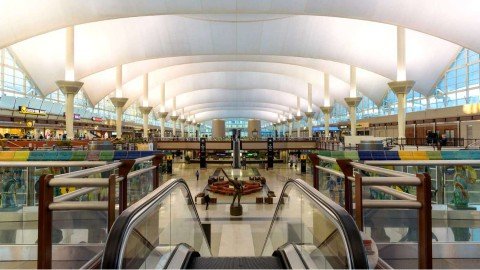

But the magic of the roof does not end in its appearance, but in its function. An innovative Teflon-coated fiberglass roof system allows approximately 10% of visible light to pass through during the day, efficiently reflecting 90% of the most severe solar radiation. This clever design significantly reduces heat gain, maintaining a cool and pleasant environment for travelers, even on the hottest days.
Denver International Airport is a living testament to how architecture and nature can merge in a harmonious, environmentally friendly dance. Every corner of this architectural marvel is a showcase of human ingenuity and an invitation to explore the world from the comfort and beauty of a design that connects us with the grandeur of nature.
Get ready to step into an airport that goes beyond the conventional, where creativity and sustainability come together to bring to life a unique travel experience. Welcome to Denver International Airport, where architecture becomes a tribute to nature and innovation, and every visit becomes an indelible memory in the minds of travelers.
Location: Denver in Colorado, U.S.A.
Design: Fentress Architects
Chhatrapati Shivaji Airport (Mumbai) India


We step into a setting of architectural wonder and sophistication, where Chhatrapati Shivaji International Airport in Mumbai, India, becomes a testament to the masterful fusion of modern design and the region’s rich traditions. At the heart of this majestic infrastructure is the impressive Terminal 2, a creation of renowned architectural firm SOM, which elegantly embraces India’s historical legacy.
With a capacity to receive around 40 million passengers per year, Terminal 2 is a symphony of aesthetic detail and intricate planning. Inspired by regional context and traditional architecture, this masterpiece is a tribute to deep-rooted Indian arrival and departure traditions, transcending functionality to transform every travel experience into an exciting cultural encounter.
The structural design is a work of art in its own right, with mega columns standing as imposing witnesses to the fusion of modern and traditional. Inspired by regional architecture, these filtering columns dance with the light, creating a play of shadows and lights that evoke a magical and mysterious spirit.


Every detail on the ceiling is an architectural gem in itself. With coffered ceilings and intricate jaali screens, light filters and dances, creating a cozy and serene atmosphere inside the terminal. The wise integration of regional elements into the modern design is a statement of India’s cultural identity, a tribute to its history and ancestral traditions.
Terminal 2 at Chhatrapati Shivaji International Airport is much more than a place of transit; it is a space where the past and the future converge in a harmonious embrace. Every corner of this terminal is an invitation to immerse yourself in the cultural and architectural richness of India, where innovation and respect for traditions intertwine to offer an unforgettable travel experience.
So prepare to be captivated by the charm and sophistication of Terminal 2, an architectural sanctuary that awakens awe and wonder. Welcome to Chhatrapati Shivaji International Airport, where the architecture is a love song to India’s rich cultural heritage and where every journey is an opportunity to discover the magic of a design that transcends time and space.
Location: Mumbai, India
Design: SOM – Skidmore, Owings and Merrill
Pulkovo Airport in Russia

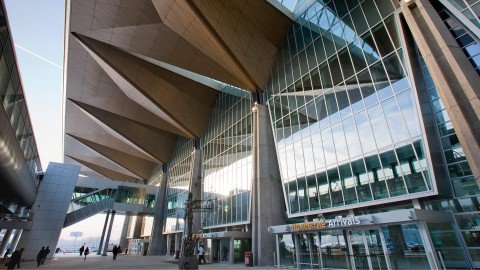
Welcome to an exceptional corner of Russia, where architecture and culture merge in an eternal embrace. We are located at Pulkovo International Airport, located in St. Petersburg, an authentic representation of the heritage and cultural richness of this magnificent city. Designed by the iconic architect Grimshaw, in collaboration with Pascall + Watson and Ramboll, this airport is much more than a transportation infrastructure: it is an emblem that transports us through time and the spirit of the region.
Pulkovo Airport, the third largest airport in the country, is an architectural tribute to the grandeur of St. Petersburg. Its design reflects the city’s cultural legacy and becomes an icon that honors its history and traditions. With the first phase completed, this masterpiece has the power to transfer an impressive 12 million passengers each year, who will be in awe from the moment they set foot in this land of elegance and splendor.
The Pulkovo Airport roof is a work of engineering and aesthetics in itself. With a predominantly flat design, it consists of 12 bays 18 meters wide, an arrangement that not only protects the interiors from intense sunlight, but also evenly distributes snow loads. This intelligent and functional architecture becomes a stage for light and transparency thanks to the insertion of prisms, which act as a large roof illumination. Every corner of the terminal is bathed in natural light throughout the day, creating a feeling of spaciousness and warmth in every space.


Pulkovo International Airport is a love letter to architecture and culture, a visual narrative that celebrates the grandeur of St. Petersburg. Every detail, every shape, every corner is an invitation to immerse yourself in the magic of this historic and cultural region.
So get ready to embark on a journey through the architecture and history of St. Petersburg at Pulkovo Airport. Welcome to an experience that transcends the ordinary, where every step is an encounter with the past and the future, where design and culture intertwine to offer an unparalleled spectacle – welcome to Pulkovo International Airport!
Location: St. Petersburg Russia
Design: Grimshaw, Pascall + Watson, Ramboll
Heydar Aliyev Airport in Azerbaijan


We embark on a journey of discovery at Heydar Aliyev International Airport, an architectural gem designed by the prestigious Istanbul-based Autoban studio. At this destination, contemporary architecture blends with rich cultural heritage, creating a unique and exciting experience for all travelers who have the privilege of passing through its gates.
The interior of this terminal is an ode to elegance and originality, a perfect combination of modernity and tradition. Wood stands as the protagonist material, enveloping the passenger spaces in cozy wooden cocoons. These elements extend throughout the terminal, giving life to cafes, kiosks and other amenities, providing a cozy refuge amidst the hustle and bustle of travel.
The terminal at Heydar Aliyev International Airport becomes a tribute to the power of natural materials in architectural design. Every corner is a showcase of human ingenuity, where wood adds warmth and character to the terminal space, creating an enveloping and welcoming atmosphere for travelers. The well-lit interiors become a canvas where light highlights the beauty of every detail, highlighting the elegance of this masterpiece.

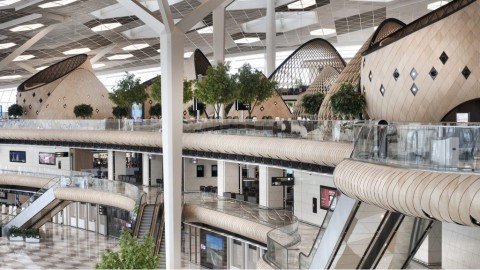
But the design magic doesn’t stop there. Autoban has taken advantage of lighting to further enhance the passenger experience. Strategically placed lighting elements accentuate the beauty of the natural materials used, adding an extra dimension of splendor and sophistication to the space.
Heydar Aliyev International Airport becomes a love letter to tradition and innovation, a setting where architecture and culture meet in an eternal embrace. Every corner is an invitation to explore, to feel and connect with the very essence of the region.
So prepare to be captivated by the elegance and charm of Heydar Aliyev International Airport. Welcome to a space where architecture and culture intertwine to offer a unique and enriching experience – welcome to an exciting journey that celebrates the beauty of tradition and innovation!
Location: Baku, Azerbaijan
Design: Autoban
Kempegowda Airport (Terminal 2) India


We are at Kempegowda International Airport, where the second terminal stands as a tribute to the very essence of Bangalore, the “Garden City”. Designed by the prestigious SOM architectural firm, this terminal is a testament to the harmony between nature, culture and the city’s traditional architecture.
Growing passenger traffic necessitated a phased design, but every step of this construction has been a tribute to Bangalore’s legacy. Inspired by the beauty of this “Garden City,” the terminal’s design seeks to connect travelers with nature and local culture from the very moment they set foot in it.
The interiors are a canvas of inspiration, where nature and culture merge into a visual symphony. Every corner has been inspired by the richness of the region, and the design becomes a window into the enchanting world of Bangalore. The interior garden and landscaped shopping areas frame the passenger experience, providing a relaxing and welcoming environment that honors the very essence of the “Garden City”.


Stunning ceilings with natural materials and unique elements create a sense of awe at every step. Brick walls, terrazzo floors and a bamboo roof become symbols of the connection between the past and the future, where sustainability is embraced with aesthetics and tradition.
The Kempegowda International Airport terminal is an example of sustainable and eco-friendly design. Each feature has been carefully conceived to achieve significant energy savings and to honor the spirit of nature surrounding the lagoon that captures rainwater, which in turn can be reused. This conscious approach is a statement of commitment to the environment and responsibility to the future.
Prepare to embark on a unique experience at Kempegowda International Airport, where architecture and nature come together to celebrate the beauty of Bangalore and its cultural heritage. Welcome to a destination where every journey becomes an intimate connection with the “Garden City” and its enchanting spirit!
Location: Bangalore, India
Design: SOM – Skidmore, Owings & Merrill
Hamad International Airport in Qatar


We are standing in a true architectural treasure in the state of Qatar: the Hamad International Airport passenger terminal complex. This terminal is much more than a transportation infrastructure, it is a forceful and contemporary expression of Qatar’s cultural heritage, as well as a symbol of the region’s progressive growth and development.
The design of this terminal is a tribute to the organic forms and natural beauty of Qatar. The soft, flowing curves that characterize it evoke the majesty of the dunes and ocean waves, creating a perfect harmony between man and nature.
The steel and glass framed structure is a statement of transparency and luminosity. An unobstructed ceiling floods the terminal space with natural light, creating a welcoming and luminous atmosphere for passengers. Every corner of this terminal is a stage of light and shadow, where reflections dance in an ethereal dance.


But the terminal’s charm doesn’t stop there. The wooden ceiling, which contrasts with the material palette of metal and glass, adds a warm and welcoming feel to the environment. This choice of material not only has local significance, but is also a testament to a commitment to sustainability and a long service life.
The Hamad International Airport passenger terminal complex is a love letter to Qatar’s cultural and architectural identity. Every detail of this terminal is an invitation to explore the richness of the region and celebrate the progressive development of this thriving state.
Prepare to be captivated by the expressiveness and beauty of Hamad International Airport. Welcome to a travel experience that transcends the ordinary, where architecture and culture intertwine in an everlasting embrace. Welcome to a destination where every step is an encounter with the greatness of Qatar and its innovative spirit!
Location: Doha, Qatar
Design: HOK
In short, the 10 most incredible airports in the world are true architectural marvels and testaments to creativity and innovation in design. From Beijing Daxing International Airport, with its organic form and capacity to accommodate millions of passengers, to Madrid-Barajas Airport, which stands out for its sustainable design and seamless integration with its surroundings, each terminal invites us on a journey beyond the conventional.
In Singapore, Changi Airport stands as a jewel inspired by nature and tradition, where the travelers’ experience becomes an encounter with a garden paradise. While at Queen Alia International Airport in Jordan, the passive and sustainable design is a tribute to harmony with the region’s climate and culture.
In the United States, Denver International Airport surprises us with its peaked roof and efficient design that reduces heat gain, while in Russia, Pulkovo International Airport captivates us with its expressive, contemporary architecture, reflecting the region’s dunes and ocean.
Bangalore, India, presents a design inspired by nature and culture at Kempegowda International Airport, where interiors become cocoons of wood and sustainability is the key to a harmonious experience.
Finally, in the state of Qatar, Hamad International Airport welcomes us with a terminal that stands out for its elegance and luminosity, contrasting the wooden ceiling with the subtle palette of metal and glass materials.
Each of these airports is an architectural landmark that transcends mere functionality, immersing us in a unique and exciting experience on every trip. From Alher Sem, we are honored to have introduced you to these amazing and iconic destinations, which have taken architecture to new heights and inspire us to discover the world from their splendor. Welcome to a journey where design and culture converge to offer us an unforgettable travel experience in the 10 most incredible airports on the planet!
Comments
We are interested in your opinion, please leave us a comment